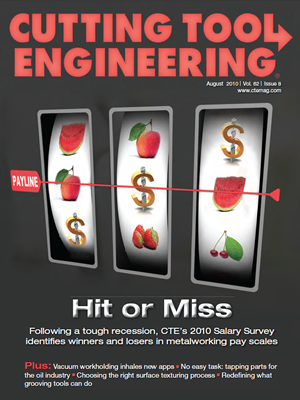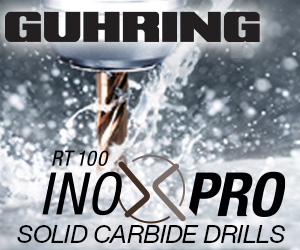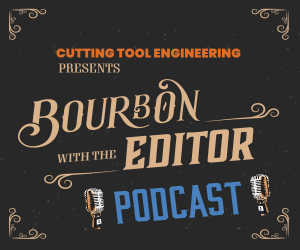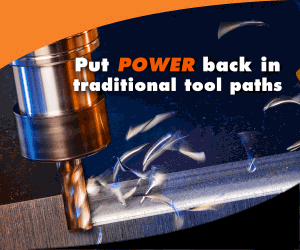August 2011 | Vol. 63 | Issue 8
Examining the development and evolution of drill/tap-style machines; horizontal boring mills are behemoth in size and flexibility. PLUS:
- When applying finishes to parts, shops have a key choice: outsource or DIY
- Grooving hardened steel parts with PCBN cutting tools
- Controlling foam when applying high-pressure coolant requires trade-offs to achieve effective machining
- New imX event offers education ranging from one-on-one instruction to panel discussions on the future of manufacturing.
July 2011 | Vol. 63 | Issue 7
Improved holemaking efficiency drives powertrain machining throughput; a qualified approach to machining complex, deep holes. PLUS:
- Improving productivity when changing cutting tools
- Advances in machine tool technology, tooling and software facilitate high-productivity milling strategies
- Advanced machine technology requires advanced training options
- “Do-it-yourself” route appealing to more dentists who install prostheses.
June 2011 | Vol. 63 | Issue 6
The use of plastic medical parts is growing, and in certain applications machining them is advantageous and even essential. PLUS:
- Machining fiber-reinforced composite materials with fiber and other types of lasers can be an effective option
- Some part makers are bringing inspection technology to the shop floor for quality control—with good results
- Reamers are an effective option for hole finishing, but choosing the right one for the job depends on hole type, diameter and depth, among other factors
- Equipment and media options for cleaning automotive parts
- A novel approach to micromachining involves mounting the workpiece in the machine spindle and machining it with a stationary cutting tool mounted on the table.
May 2011 | Vol. 63 | Issue 5
Superabrasive wheels add science to the art of polishing; developments in superabrasive grinding wheels for producing ceramic balls; and various edge preparations are available for PCBN inserts when hard turning, but not all are equal. PLUS:
- 5-axis machining on a vertical machining center doesn’t have to be complicated
- Adjustable finish boring heads allow for a range of diameters to be machined with one tool
- Cold forming is a fast, chipless way to make parts.
April 2011 | Vol. 63 | Issue 4
Cavalier Tool uses a palletized machining center to reduce setup and benching times and bring outsourced hard milling work in-house. PLUS:
- Mass finishing parts at the machining center offers economic advantages
- Shop takes ‘systems’ approach to holding microparts
- Tactics and tools for Swiss-style machining
- Technical advances enable ceramic inserts to tackle difficult machining applications.
March 2011 | Vol. 63 | Issue 3
Parts manufacturers are gearing up to serve the nuclear power industry, which is growing globally and expected to expand in the U.S. as well; Hunting Energy Services not only machines oil and gas drilling components—it assembles and repairs the tools that do the work. PLUS:
- Technology opens up new applications for small horizontal machining centers
- Using countersinking to increase part functionality
- Comparison between calculating cutting time when facing at a constant cutting speed vs. a constant rpm.
February 2011 | Vol. 63 | Issue 2
When it comes to milling aerospace parts made from Ti5553, difficulty is in the eye of the beholder. PLUS:
- Turning a lathe vertical can be a productivity turn for the better—for large and small parts
- CAM and simulation software packages enable productive programming of multitasking machines—particularly as they become ‘ultratasking’ machines
- Strategies for grinding HVOF-coated aerospace parts
- Learn details about the many new products manufacturers off er the metalworking industry.
January 2011 | Vol. 63 | Issue 1
Drilling stacked materials, which have alternating layers of composites and metals, requires a careful strategy and the right tools. PLUS:
- Simplified application of 5 machining axes produces big cost savings in routine part making
- With a structured cutting tool repair program, significant cost savings are realized while tool quality remains intact
- Boosting milling productivity requires an understanding of the process
- Tips and techniques that can turn a standard milling job into a work of art.
December 2010 | Vol. 62 | Issue 12
With the right tools, thread milling large bore diameters doesn’t have to be daunting; tapping isn’t easy and one of the toughest challenges is preventing oversized threads. New tools can help. PLUS:
- More flexible grinding machines allow part manufacturers to fine-tune their production processes
- Toolmakers combine technologies to meet growing demand for PCD tools
- Connectivity converts presetters into shopwide productivity boosters
- An out-of-level grinding machine can cause major operating and part quality problems—the good news is the solution is simple
- The metalworking industry trended up in 2010
- Learn about companies’ specialties as suppliers to the metalcutting industry.
October 2010 | Vol. 62 | Issue 10
New materials and improved part manufacturing help maintain and upgrade aging military aircraft. PLUS:
- Nanotechnology opens up new coating possibilities, performance
- Better technology boosts use of EDMs for production applications
- A look at portable measurement technologies and their applications
- It’s never been easier to recycle cutting tools, which produces both cost savings and environmental benefits
- Learn details about the many new products manufacturers offer the metalworking industry.
September 2010 | Vol. 62 | Issue 9
Machining P/M steels for auto parts is tough, but answers abound. PLUS:
- 5 shops use different lights-out machining strategies, but all are focused on creating stable processes
- Advancements in marking technology lead to lower integration costs and more benefits for the end user
- The real cost of a cutting tool
- Designing machine tools for cutting titanium—especially 5553
- Using accessories to maximize machine performance.
August 2010 | Vol. 62 | Issue 8
CTE’s 2010 Salary Survey looks at the wages for metalworking positions since the 2008 survey, and how benefit packages have changed. PLUS:
- Vacuum workholding is catching on in new and different applications
- Like the parts they thread, taps for oil and gas parts can be complicated
- Shops have many choices when texturing—rather than smoothing—part surfaces
- Multifunction groove/turn tools stretch shops’ definition of a grooving tool
- Metalworking fluids can play a significant role in boosting machining productivity when engineered to provide cooling and lubrication
- Tool combination is used to automate drilling, reaming and deburring of chamfered through-holes for jet-engine fasteners.





















